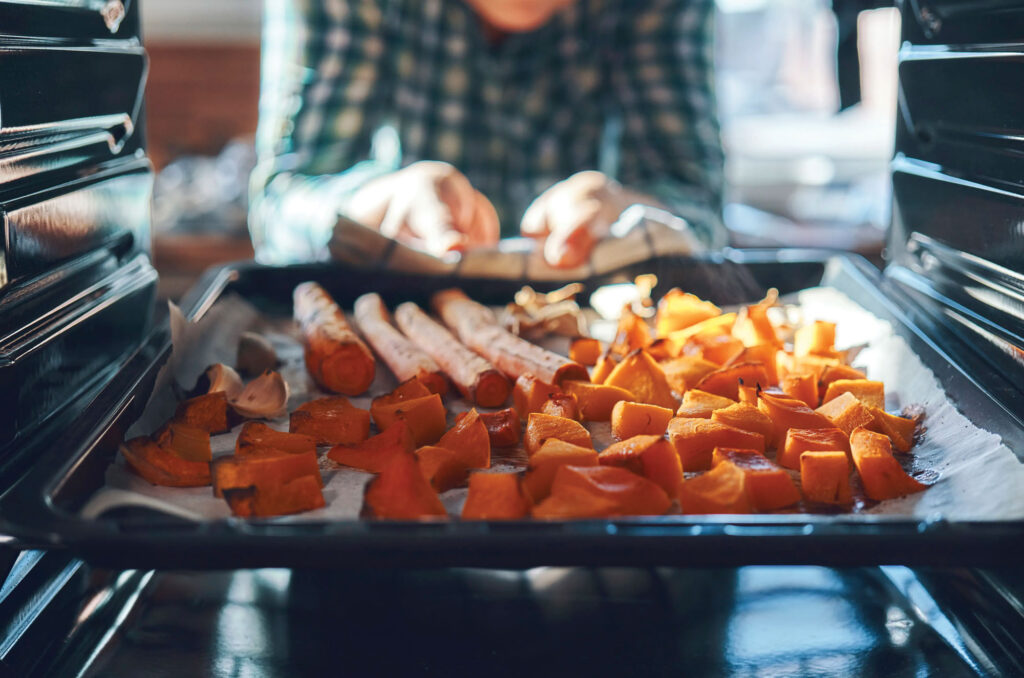As we welcome the cooler weather and look forward to planning our Thanksgiving feasts, it’s easy to wonder whether we might make the holiday spread a bit healthier and more nutritious for our family and friends. Sandwiched between Halloween and Christmas, this time of year can feel quite indulgent. And yet, the celebration just doesn’t quite feel the same without our beloved favorite dishes . . . so what can we do? Well, there’s certainly no need to throw out your favorite menu. Just start with where you are and consider small shifts to keep the holiday feeling the way you are used to, with a little nutritional boost from a few key tips.

A healthy Thanksgiving starts with bringing dish ingredients closer to the form it took in nature and adding more veggie dishes.
Strategy 1: Reduce or substitute refined ingredients
Wherever possible, shift your ingredients to slightly less processed options, with fewer refinement steps. Start with one or two dishes for which you can select slightly less refined ingredients than normal. As a general guideline, try to bring the dish (or the ingredients) at least one or two steps closer to the form it took in nature. For example, if you usually get cranberry sauce from a can, try making it from scratch, swapping cane sugar out for a lower-glycemic option like coconut sugar. If you purchase a pie, check the ingredients and select an option that uses butter or coconut oil instead of shortening (which contains trans fats) and look for the shortest, most legible list of ingredients to avoid synthetic additives and preservatives. If you make your own pies, try decreasing the amount of refined sugar or replacing it with coconut sugar, maple syrup or honey, which all have trace vitamins and minerals that white sugar does not contain.
Consider replacing some white flour with whole wheat flour in recipes where it won’t affect the backing process. Replacing all-white flour with a blend of white and whole wheat increases fiber and B vitamins. Depending on the recipe, you can generally swap between V and W of the white flour for whole wheat without affecting how it performs in the oven.
In addition to the examples above, here are some other easy swaps:
- Replace white potatoes with sweet potatoes, which have a lower glycemic value and higher fiber content.
- Leave in fiber-rich peels when edible (potato, sweet potato, apples, pear, etc.).
- Replace canned, premade or frozen options with from-scratch alternatives.
And when in doubt, simplify! You don’t need a 37-step recipe to make the perfect anything. Return to the basics and de-stress your Thanksgiving prep work.
Strategy 2: Amp up the veggies
Try to add at least one more vegetable dish. Vegetables are rich in fiber, vitamins, and minerals and (aside from potatoes) generally low in starches and calories. Consider what is in-season. Brussels sprouts, kale, and collards are all cool weather vegetables.
Sweet potato, pumpkin, and winter squash are classic options and roast well, especially in combination with other root veggies such as carrots and beets. Start by chopping them up into similar sizes. Drizzle with a bit of avocado oil or another healthy oil with a high smoke point, sprinkle with some sea salt and chopped herbs (fresh rosemary, thyme, and sage are classic and delicious) and cook in the oven at 425ºF for about 30-45 minutes or until soft enough for a fork to pierce. The timing will depend on the size of the veggies and the specific vegetables you select, so check on them often.

Roasted winter vegetables are a classic healthy Thanksgiving side dish.
If oven space is precious, you could also consider easily steamed options like broccoli, cauliflower or green beans. Mushrooms (while technically a fungus and not a vegetable) are also delicious, filled with fiber and nutrients and are tasty baked or sautéed. It’s easy to sauté any dark leafy green (kale, collards, bok choy, spinach) in a bit of olive oil with a pinch of salt. When the greens are at the right texture, remove from the heat and add a squeeze of fresh lemon juice to help preserve the vibrant color.
Strategy 3: Take time to savor your meal
Did you know that when you eat slowly and calmly, you activate your parasympathetic nervous system? It’s true. This is known as the “rest and digest” nervous system. It’s the opposite of the sympathetic nervous system (or “fight or flight”) that engages when we are rushed, anxious or stressed. If you take the time to enjoy the company and savor the delicious meal you have prepared, you will be able to digest your food better! So, chew, savor, take time to speak and reminisce with loved ones and relish your meal with gratitude and calm. You›ve earned it.
Posted in: Health & Nutrition
Comment Policy: All viewpoints are welcome, but comments should remain relevant. Personal attacks, profanity, and aggressive behavior are not allowed. No spam, advertising, or promoting of products/services. Please, only use your real name and limit the amount of links submitted in your comment.
You Might Also Like...

Protecting Kids from Diet Culture
David’s mom is fat. She needs to go on a diet.” When my sweet kindergartener innocently uttered this line after school one day, I couldn’t hide my shock. After experiencing […]

Choosing Where to Give Birth
Where your baby will be born is a matter of utmost importance. Hospital, home, or birth center—sit down with your partner and have a cup of pregnancy tea as you […]

The Well Stocked Pantry for a Successful Cooking Experience
The secret to being a good home cook is having a well-stocked pantry. This doesn’t mean having everything under the sun in your pantry (and never using half of it). […]

What Parents Should Know About North State’s Rising Fentanyl Problem
Courtesy of Shasta County Health & Human Services Agency and Mister Brown of The Choose Well Program Across the nation, fentanyl-related overdoses are increasing at an alarming rate. And, youth […]




